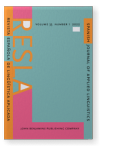Vol. 35:1 (2022) ► pp.30–64
Vol. 35:1 (2022) ► pp.30–64
Simultaneous interpretation of complex structures from English into Arabic
A complex sentence is described as such by virtue of its multiple constituents which vary from clauses, subclauses to phrases. English and Arabic linguistic literature includes references to the issue of syntactic complexity, yet the approaches are different. The present study seeks to investigate how Arab simultaneous interpreters translating from English into Arabic deal with syntactically complex structures. To achieve this goal, the final debate between Hillary Clinton and Donald Trump is selected as the test-ground. The study finds that simultaneous interpreters operating from English into Arabic deal with complex structures in different ways by adopting and adjusting their strategies. The dominant strategy is linearization, which is triggered by the need to translate under time pressure. This strategy also unloads the simultaneous interpreter’s cognitive burden. Yet complete linearization is impossible, since omission and compression may interfere as in the case of embedding and ‘that’ structures. Other strategies, particularly addition and chunking, are also observable, being applied when interpreters find themselves faced with asyndetic structures and multiple embedding.
Article outline
- 1.Introduction
- 2.Syntactic complexity in English
- 3.Syntactic complexity in Arabic
- 4.Syntactic complexity in simultaneous interpretation
- 5.Hillary Clinton’s style
- 6.Statement of the problem
- 7.Methods and materials
- 7.1Corpus
- 7.2Methodology
- 8.Analysis of the data
- 8.1Embedding
- a.Multiple embedding
- b.Multiple embedding plus apposition
- c.Multiple embedding plus apposition plus subordinators
- 8.2Inverted structures
- 8.3Asyndetic structures
- 8.4Noun clause as subject
- 8.5Multiple subordination
- 8.6Dangled ‘that structure’
- 8.1Embedding
- 9.Conclusions
- Notes
-
References
